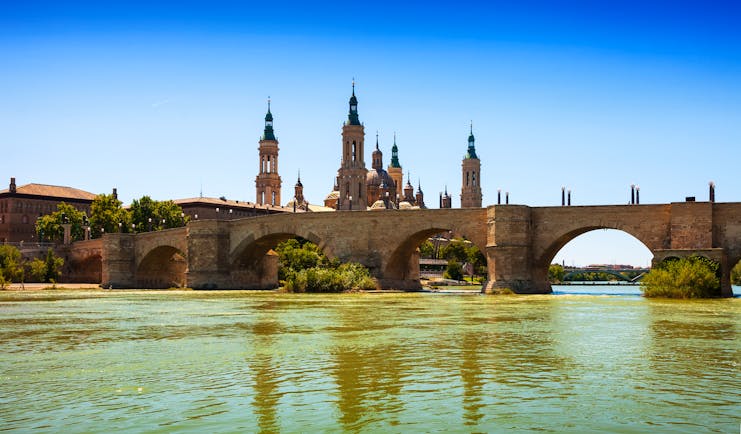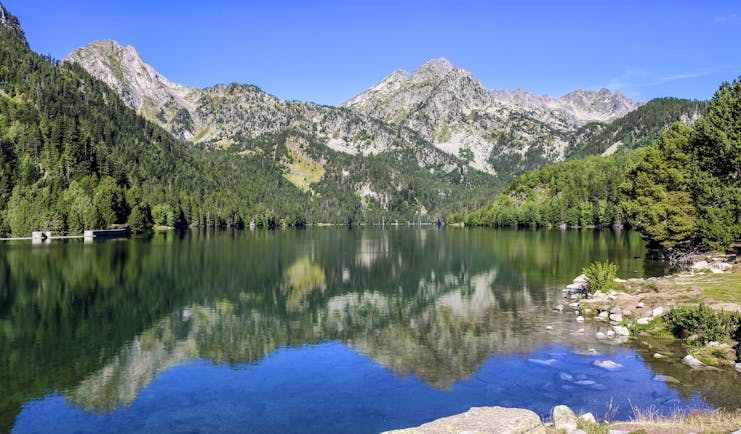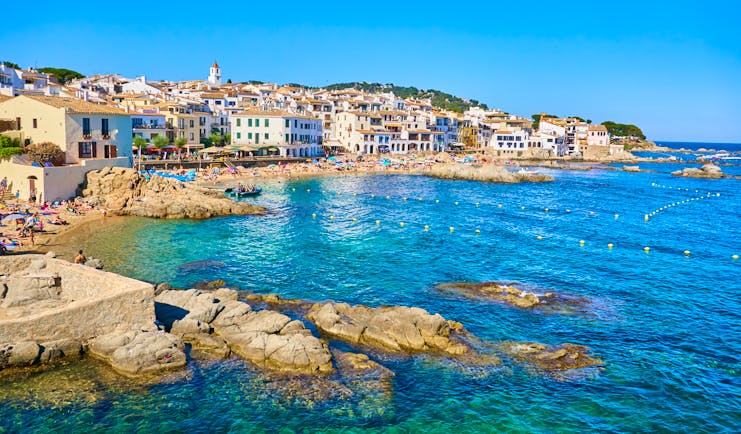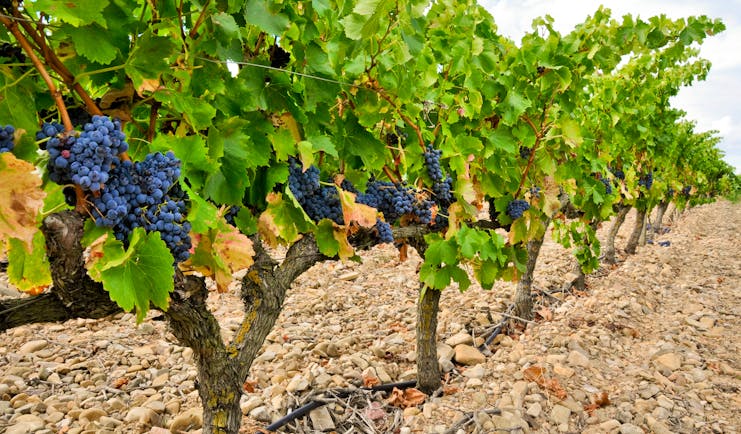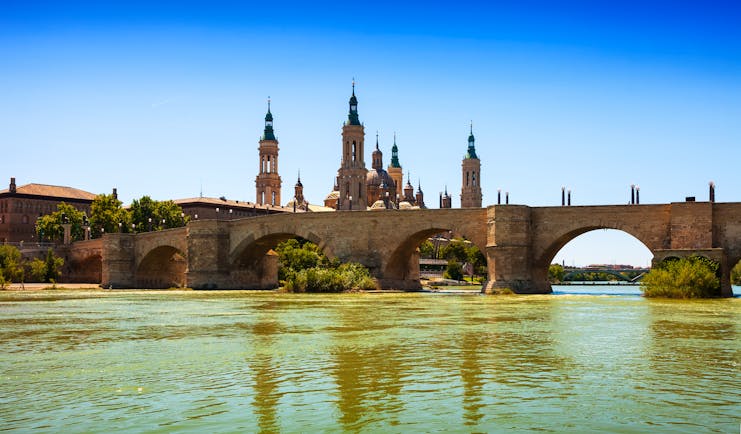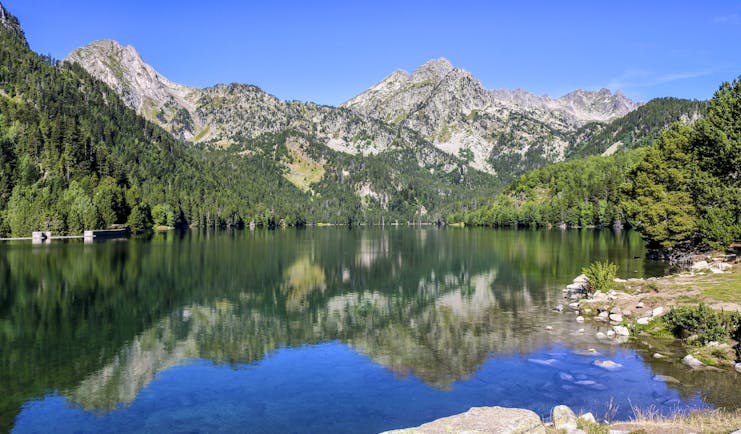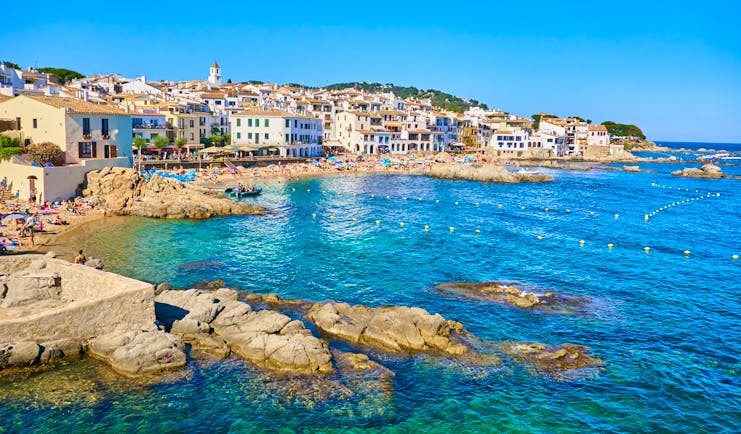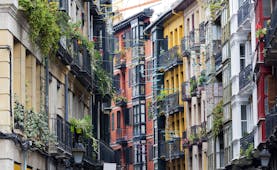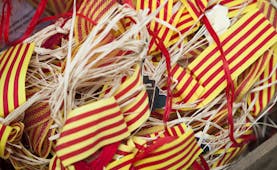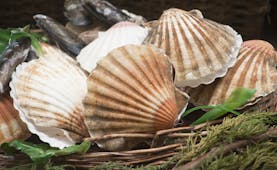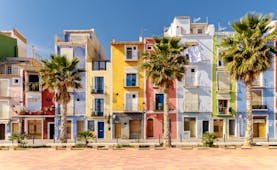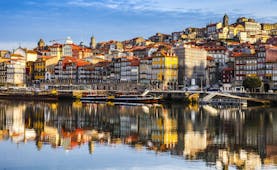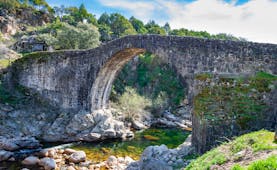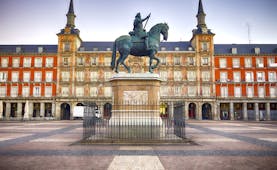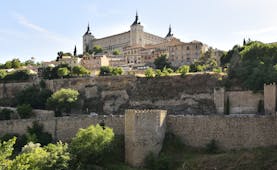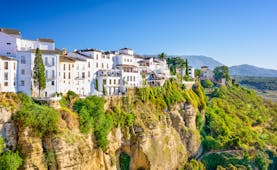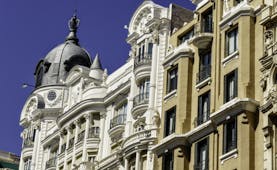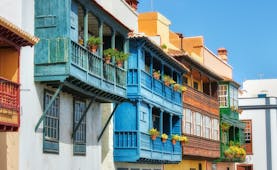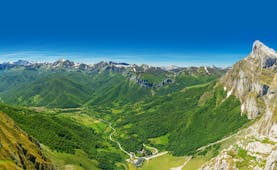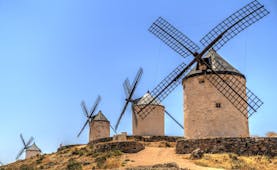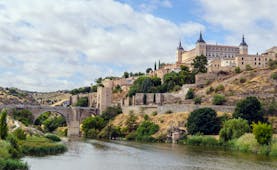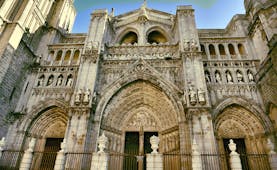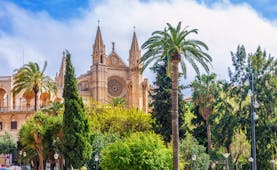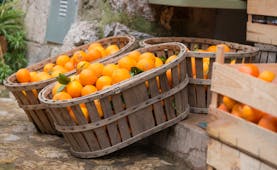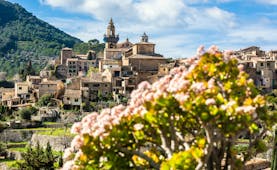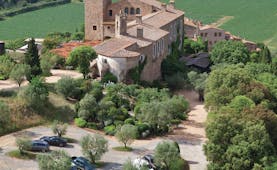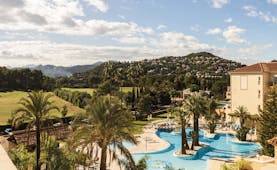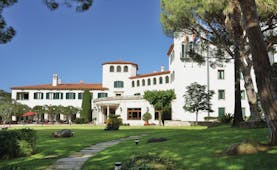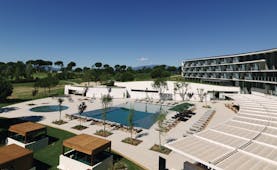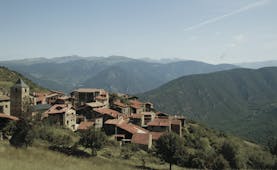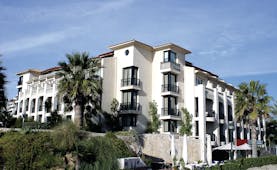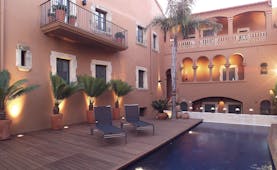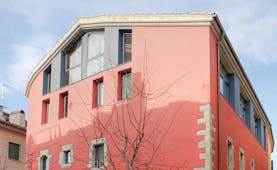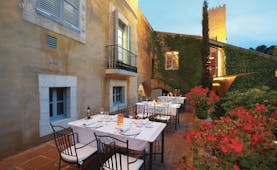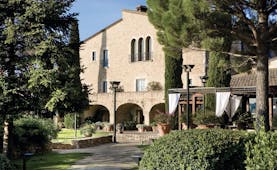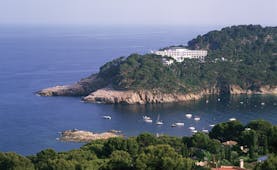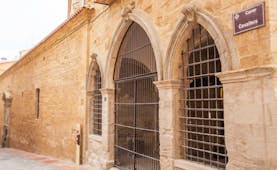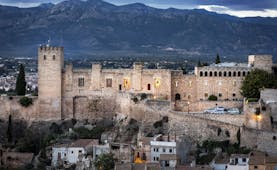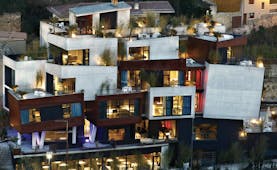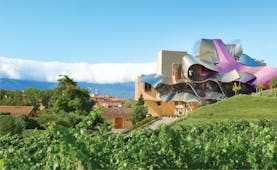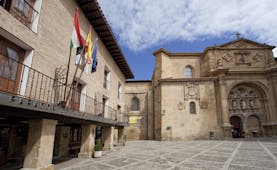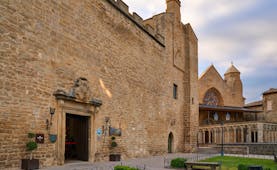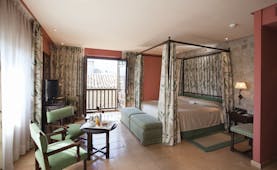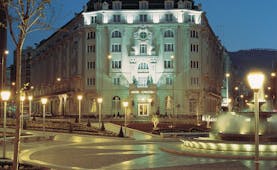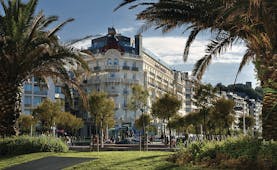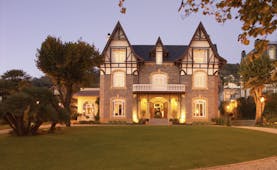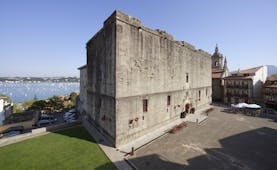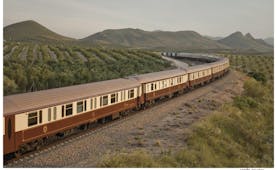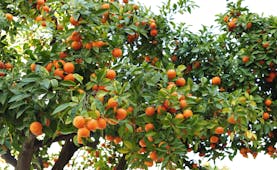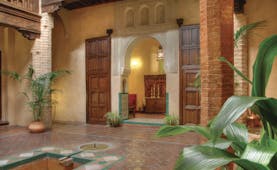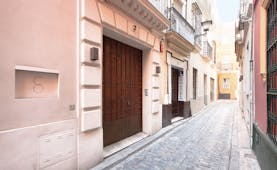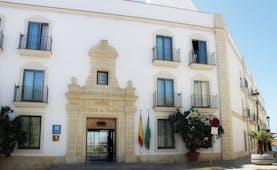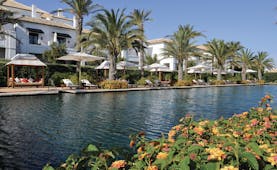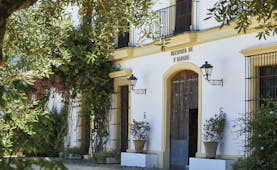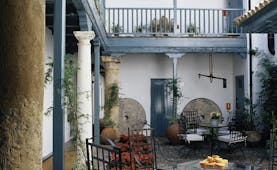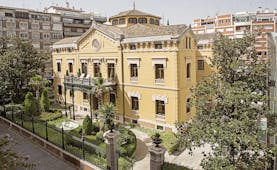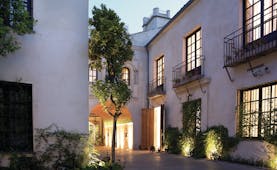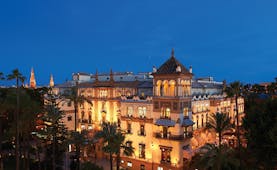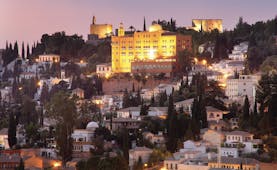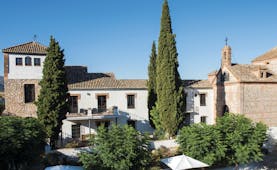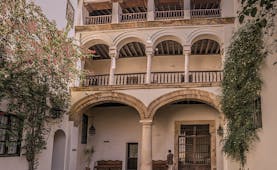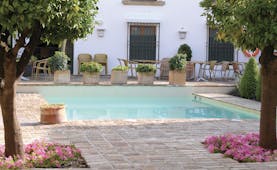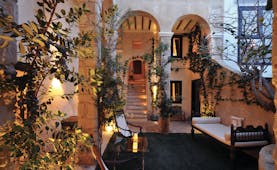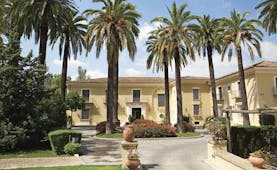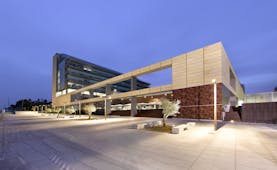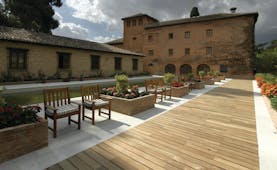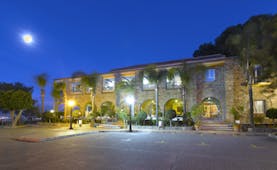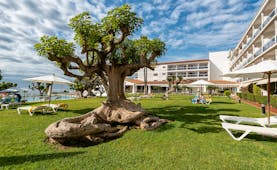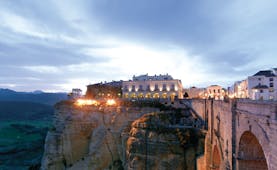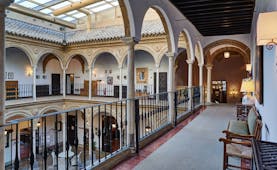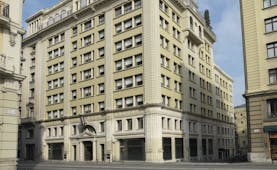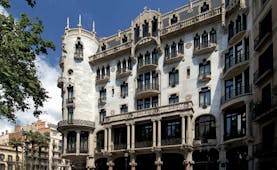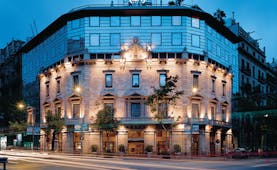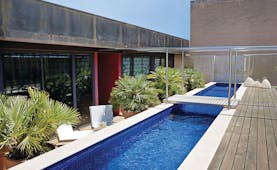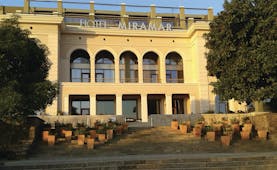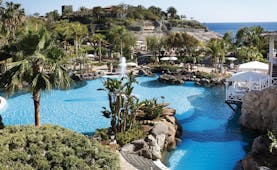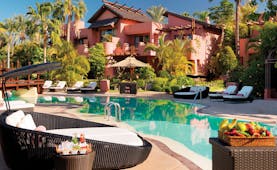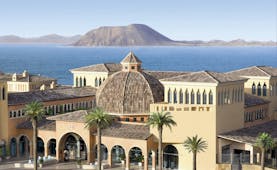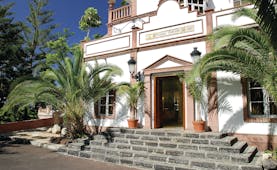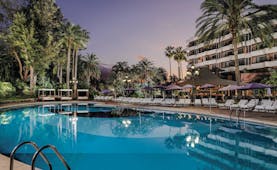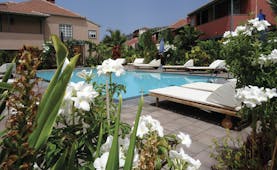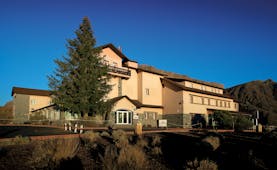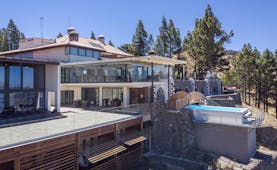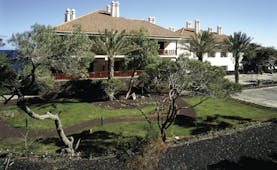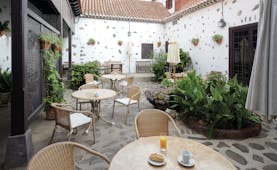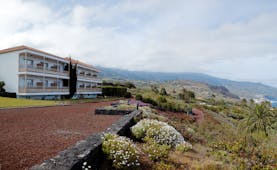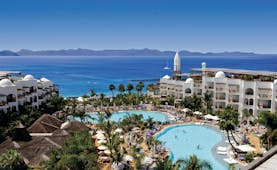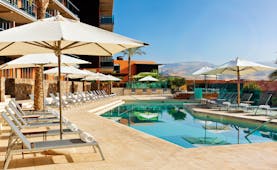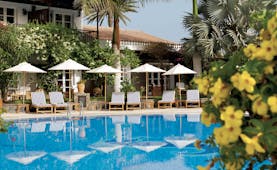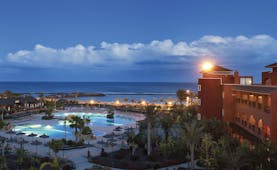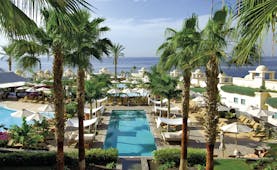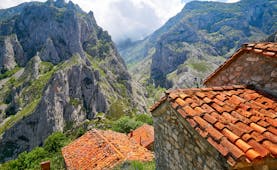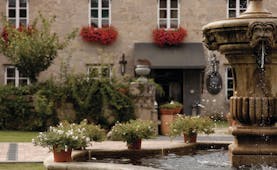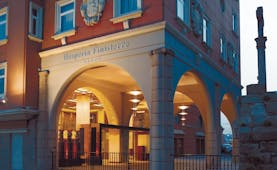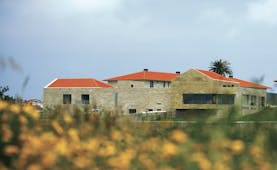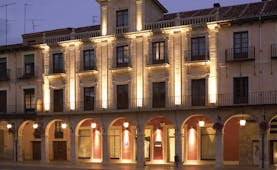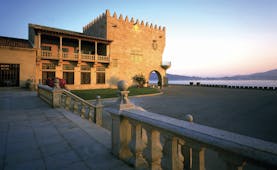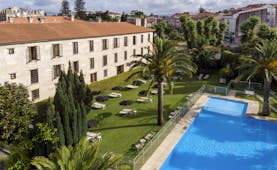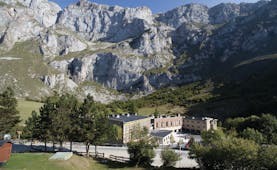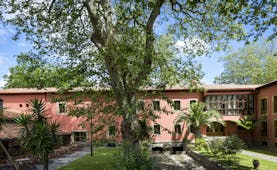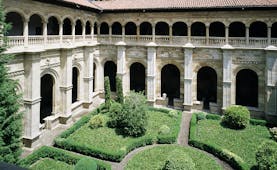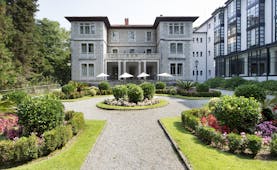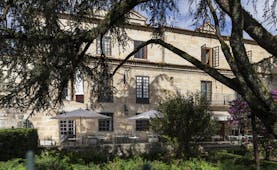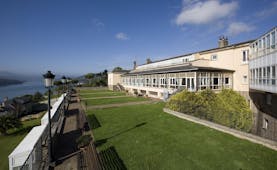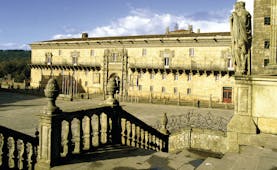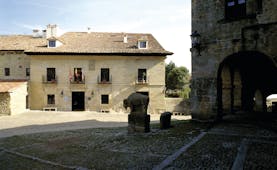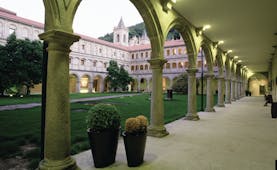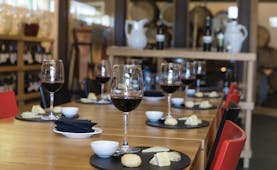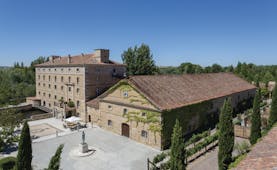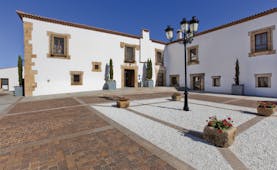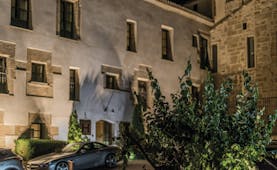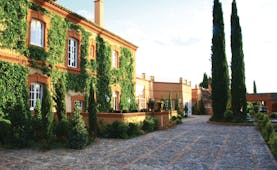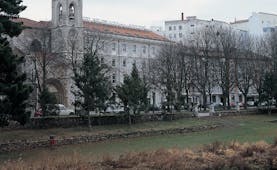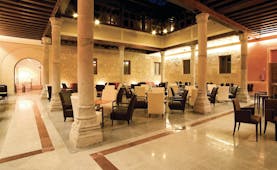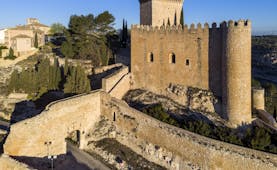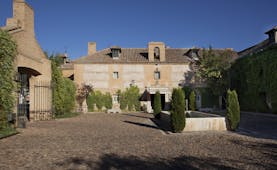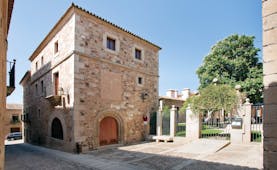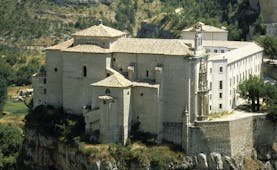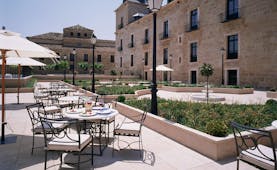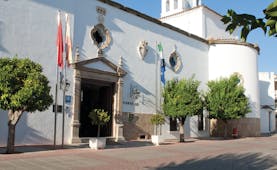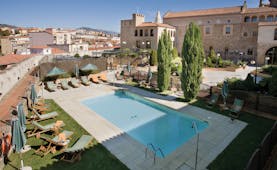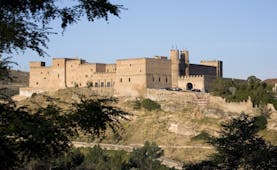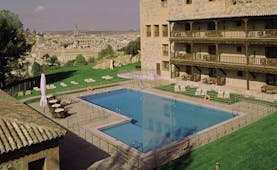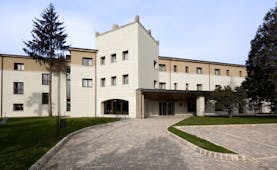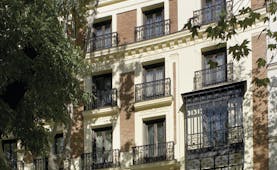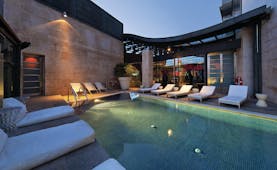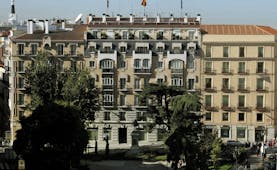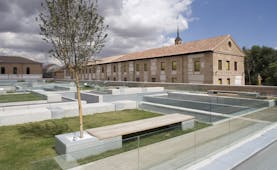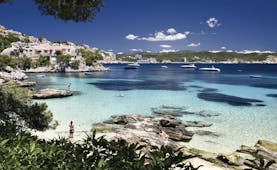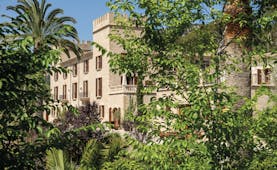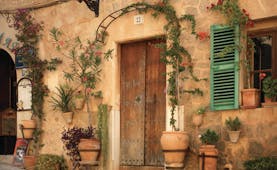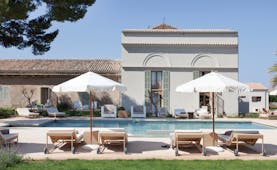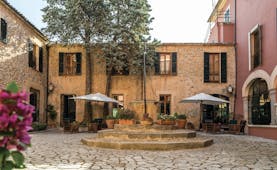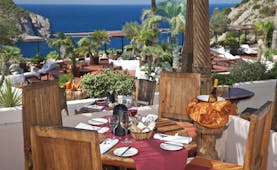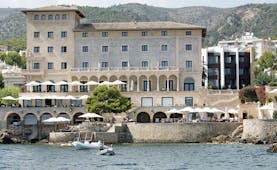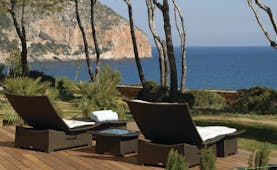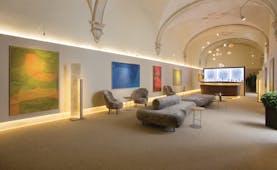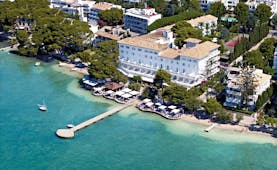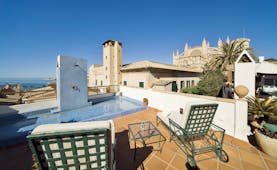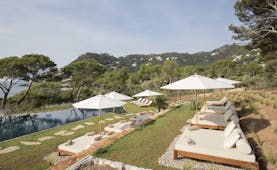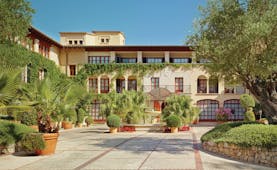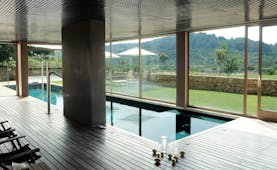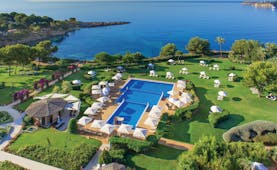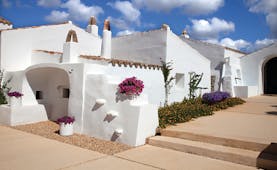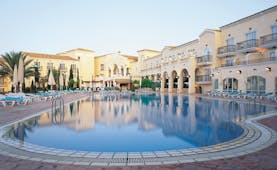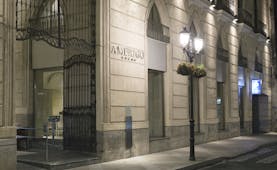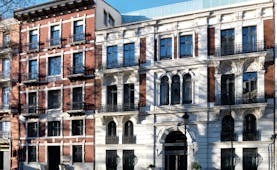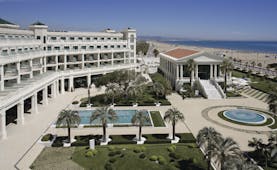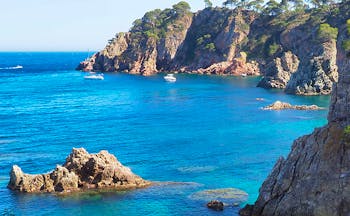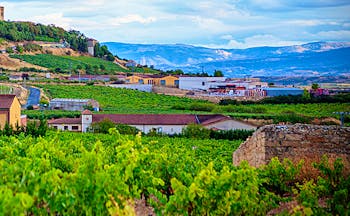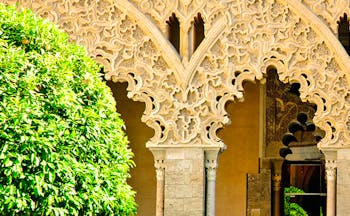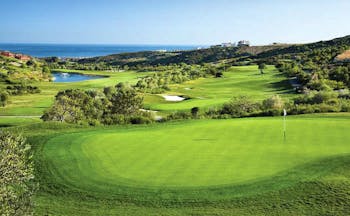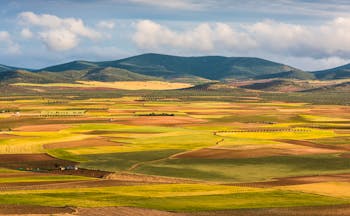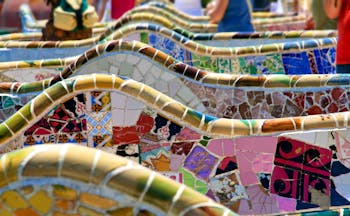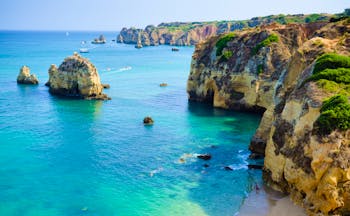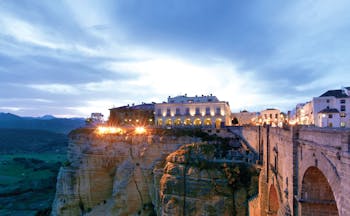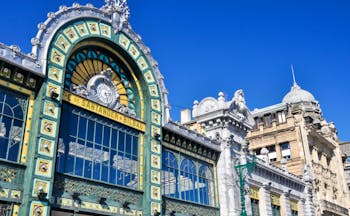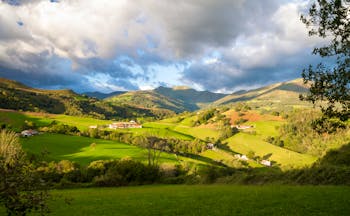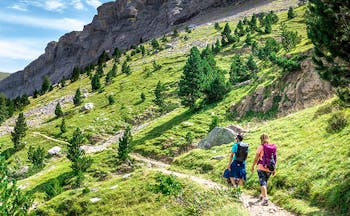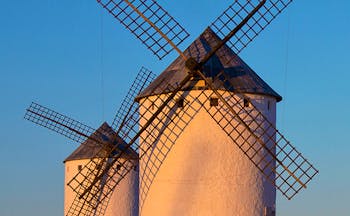Luxury fly-drive touring holiday from the Basque Country to Catalonia visiting La Rioja and Aragon
This 10-night fly-drive luxury touring holiday of north-eastern Spain takes you on a coast-to-coast journey through the Spanish regions of the Basque Country, La Rioja, Aragon to arrive in Catalonia. On your journey you explore the fashionable towns and long sandy beaches in the Bay of Biscay and the beautiful vineyards of the Ebro valley in La Rioja. From here you then strike east through across the wide, open plains of Aragon. A medieval kingdom, this area is known for its Moorish-influenced Mudéjar architecture which you will have the opportunity to see in the regional capital of Zaragoza. Your journey brings you into Catalonia where you stop first at the historic city of Lleida before continuing towards the coast. San Sebastian is renowned as a gastronomic destination and offers a wealth of Michelin star restaurants. Despite this, the best way to explore the delights of the city is on a pintxo tour, moving bar to bar and sample these small bites at each stop. During your first stop you might like to take your hire car westwards to visit nearby Bilbao and Frank Gehry’s masterpiece – the Guggenheim museum, or perhaps head eastwards instead and across the border to the French town of St Jean de Luz. After your taking your fill of sandy beaches and fine dining, drive inland to the wine producing region of La Rioja. Spend two nights here amidst the vineyards, enjoying the finer things in life and basking in the Mediterranean sunshine. Use this stop as an opportunity to sample the best of the local wines and cuisine whilst relaxing at your hotel. For a taste of the livelier nearby towns, Logrono makes a very fulfilling day out. The drive o Lleida, your next stop, takes you past the regional capital of Zaragoza. We recommend stopping for lunch and a stroll here to see the incredible wealth of history and architecture found within the city’s limits. Highlights include the baroque Basilica, the 11th century Moorish palace and the 12th century cathedral. Lleida is your base for the next two nights. Spend your time here exploring the narrow winding streets, visiting the botanic gardens and the two cathedrals for which the town is best known. From here you travel further east and we suggest visiting the Benedictine monastery of Montserrat on your way past. The monastery’s boys’ choir sings here daily whilst the position also offers spectacular views and walking trails. Drive north from here to arrive in the village of Torrent where you spend your last three nights. Here you are 10 minutes’ drive from the mediaeval town of Pals and 15 minutes’ drive from the beaches of the Costa Brava. On one of your days here visit the nearby city of Girona with its mediaeval architecture, walled Old Quarter and the Roman remains of the Forca Vella fortress. On your last day drive south to Barcelona. Drop off your car at the airport and fly home.
Highlights
Bilbao • Guggenheim • San Sebastian • La Rioja vineyards • Villabuena de Alava • Zaragoza • Lleida • Montserrat Monastery • Torrent • Pals • Girona • Barcelona
Day by day
Start your touring holiday by flying with British Airways from London to Bilbao. Pick up your hire car on arrival and drive west to San Sebastian. If your flight arrives in the morning you might like to visit the Bilbao and the Guggenheim museum before starting your journey in earnest.
You have two days to enjoy San Sebastian. Spend your time here exploring the delights of the city, with its beautiful sandy beaches, grand architecture and renowned gastronomic dining scene. The long Playa de la Concha beach is a long stretch of sandy beach and gentle water whilst surfers can often be seen on the powerful waves at Playa de la Zurriola. Head up Monte Urgull and Monte Igueldo to enjoy some of the best views over the coastline, or take a boat out to the Isla de Santa Clara for an afternoon getaway. Back in the city centre, spend the hours discovering the elegant art nouveau buildings, beautiful parks and plazas and ornate bridges. Continue your wanders into the cobblestone streets of the Old Town before returning to your hotel to relax. You might like to consider using your hire car to visit more of the surrounding area as well as the city. The Guggenheim Museum is Bilbao is a must-do for anyone with an interest in modern art whilst driving for around 40 minutes westwards will take you across the French border to the charming resort town of St Jean de Luz. Closer at hand, you will find the nearby towns of Zarautz, Getaria and Zumaia offer a glimpse of life in this area away from the crowds. The Villa Soro does not have its own restaurant; however, the choice of venues is practically limitless. Food is truly an artform here whether you’re enjoying a light bite of fresh oysters and local txakoli wine by the beach, indulging in a decadent tasting menu in a Michelin-starred dining room or touring the pintxo bars are liberally scatter through the streets of the Old Town. First-rate ingredients from the coast and countryside are combined with the culinary creativity of Basque chefs to give an experience unlike any other.
Today you drive from the coast, heading south-west and inland to the region of La Rioja. For the most scenic route, you might like to travel via Beasain which will take you through the Natural Parks of Aizkorri-Aratz and Aralar. For those with a greater interest in history over scenery, it is also possible to take a slight detour and visit the city of Pamplona on the way. As you approach the Ebro valley the landscape opens up and you approach your hotel through a sea of vineyards that reach to the far hills.
Villabuena (Eskuernaga in the Basque language) is a traditional wine village in the heart of La Rioja. The village sits on the banks of the River Herrera and has several interesting buildings such as the parish church of San Andrés and the hermitages of San Torcuato and Santa María. Visit the village on the 15th May or 30th November to see the festivities of these local saints’ days. Villabuena is famed for its production of top-quality wines and there are 48 wineries found here, giving the town a claim to having the most wineries per inhabitant of anywhere in the world. Your hotel can organise a walking tour of some of the local wineries, giving guests the opportunity to samples these excellent vintages whilst learning more about wine production and life in this region. The nearby village of Santo Domingo de la Calzada, situated on the Saint James Pilgrimage Route to Santiago de Compostela, has numerous quiet streets and peaceful plazas that make for a thoroughly relaxing few hours excursion. For a taste of the more lively nearby towns, Logrono makes a very fulfilling day out. We recommend visiting the Concatedral de Santa Maria de la Redonda, whose main façade was designed to resemble an altarpiece. The two front towers, known as Las Gemelas, or ‘the twins,’ were built in the Baroque style, and inside, there is a painting of the crucifixion by Michelangelo. The Santo Sepulcro in one of the cathedral’s chapels is unusually detailed in tortoiseshell, silver, and wood. This stay in Villabuena de Alava offers an insight into a pocket of culture that forms and maintains one of Spain’s most famous industries.
Today you follow the River Ebro past Logrono, and skirt the border with the neighbouring region of Navarre to reach Tudela. The most direct route to Lleida continues into the region of Aragon, a medieval kingdom with crusader-like castles and Romanesque churches. We recommend stopping for lunch in the region’s capital city, Zaragoza. Overlooking the Ebro River, the iconic Nuestra Senora del Pilar draws pilgrims and tourists alike to worship and admire the multiple domes of this grand, baroque basilica. Evidence of the region’s turbulent past can be seen in the Mudéjar-style landmarks which showcase a unique combination of Islamic and Gothic architecture. Perhaps the best example of this is the Aljafería, the 11th century Moorish Palace and the Cathedral of the Saviour which dates to the 12th century. Aside from its stunning monuments, Zaragoza also has one of the best tapas and bar scenes in the country and is an ideal stopping point for lunch. Continue your journey this afternoon to arrive in Lleida.
Lleida is one of the oldest towns in Catalonia and original settlements here date back as far as the Bronze Age. Over its long history the town has been ruled by the Romans, Visigoths and Moors before being conquered by Barcelona in 1149. Your stay here gives you a chance to explore more of this eclectic history and the marks left on modern-day Lleida. The Parador is exceptionally-well located for your time here, with a pedestrianised street on one side and access to the garage on the other. A short walk of up to 10 minutes will bring you to the Old Cathedral (La Seu Vella), the “New” Cathedral and the twisting streets of the Old Town. La Seu Vella stands sentinel over the city and is well worth a visit to learn more about its history. Originally the site of a Visigothic cathedral, it was rebuilt in 832 as a mosque under the Moors. In 1149 it was then re-consecrated as a cathedral and began a significant expansion. Part of the complex, the King’s Castle, is particularly important as it has played host to many key episodes in Catalonia’s and Spain’s history over the years. The structure has almost no evidence of Islamic architecture now but has beautiful Gothic features as well as offering fantastic views over the city. Back in the main town, spend the rest of your time exploring the Eix Comercial de Lleida pedestrianised street with its shops set inside striking buildings. Spots worth visiting include the Plaza de la Paeria where you will find the 13th century town hall and Cathedral square with the “new” neoclassic cathedral and Hospital de Santa María convent. For those looking for a break, take a stroll along the quiet riverbanks or the tree-lined Rambla de Ferrán.
Drive east from Lleida and head further into Catalonia. We suggest visiting the Monastery of Montserrat on the way to your final hotel. Taking its name from the jagged mountain on which it stands, this Benedictine monastery holds a special place in the hearts of Catalans. Here you will find the shrine of the Black Madonna of Montserrat, patron saint of the region. The exact date of the founding of the monastery is unclear but religious life here certainly reaches back as far as the ninth century when hermit monks lived in solitary chapels here, one of which still exists in the monastery’s garden. Montserrat draws visitors of all faiths and none and is highly recommended to people of all interests. Many pilgrims visit the mountain as a spiritual experience to see the Madonna, the Santa Cova and attend mass. However, just as many visit to hear the famous boys’ choir, learn about the flora and fauna of the natural park and enjoy the walking trails over the mountain. The choir usually perform two times each day and there is also an art museum and audio-visual museum with more information about Montserrat. It is a further 2-hour drive from here to your hotel where you arrive in the evening.
Your last stop on this trip is the Mas de Torrent, a haven of rustic tranquillity in a luxurious converted farmhouse. From arrival, guests will notice the very special ambience created by the lovely grounds, where cypress trees climb upwards and bougainvillea blossoms add a fresh vibrancy to authentic architecture. The main building dates from 1751 and is the heart of the estate, with its original facade, interior arches and sloping rooftop. The hotel has bikes that guests can use to explore locally, visiting the unspoilt towns and villages that are scattered across the Emporda region. The town of Pals can be reached in 10 minutes’ by car or by bike for those feeling more energetic. Pals is a medieval walled enclosure which has been lovingly restored and visitors can still admire the Torre de les Hores which remains from the old castle. Pals has regular markets, festivities, fairs and concerts as well as an amazing living nativity scene in the Christmas period. A drive of about 15 minutes from your hotel heading westwards will bring you to the Catalan coastline where rugged cliffs hide beautiful sandy beaches and coves. For those wanting to squeeze a bit more in then the nearby city of Girona is worth a visit. Girona is not only known for its ancient architecture and museums but it’s also great for shopping with a host of markets and craft fairs. Visit El Lleó, the city’s food market, to try local produce from fresh seafood to fruit and cheese. If visiting on a Tuesday or Saturday then the Ribes del Ter market is a must-see. Located in Devesa Park this open-air event is the perfect place to pick up souvenirs.
Say goodbye to your hosts after breakfast and make your way south to Barcelona for your flight home. If time permits, you might like to take the slower road along the coast, perhaps stopping for lunch in one of the many towns and villages you pass through. Drop off your car at the airport and fly back to the UK. Additional nights can be added to this holiday in central Barcelona for those who would like to explore Catalonia’s capital.
Big thank you for getting us into some lovely hotels on our holiday: the suite at the Santiago parador was outstanding and Villa Soro in San Sebastian an absolute delight. We are now planning our next trip...JG, September 2022
Holiday price guide Prices from £2,660 per person based on two people sharing a double or twin room.
Holiday Code SNFD14
Call us on 01392 441245
Luxury fly-drive touring holiday from the Basque Country to Catalonia visiting La Rioja and Aragon
Start your touring holiday by flying with British Airways from London to Bilbao. Pick up your hire car on arrival and drive west to San Sebastian. If your flight arrives in the morning you might like to visit the Bilbao and the Guggenheim museum before starting your journey in earnest.
You have two days to enjoy San Sebastian. Spend your time here exploring the delights of the city, with its beautiful sandy beaches, grand architecture and renowned gastronomic dining scene. The long Playa de la Concha beach is a long stretch of sandy beach and gentle water whilst surfers can often be seen on the powerful waves at Playa de la Zurriola. Head up Monte Urgull and Monte Igueldo to enjoy some of the best views over the coastline, or take a boat out to the Isla de Santa Clara for an afternoon getaway. Back in the city centre, spend the hours discovering the elegant art nouveau buildings, beautiful parks and plazas and ornate bridges. Continue your wanders into the cobblestone streets of the Old Town before returning to your hotel to relax. You might like to consider using your hire car to visit more of the surrounding area as well as the city. The Guggenheim Museum is Bilbao is a must-do for anyone with an interest in modern art whilst driving for around 40 minutes westwards will take you across the French border to the charming resort town of St Jean de Luz. Closer at hand, you will find the nearby towns of Zarautz, Getaria and Zumaia offer a glimpse of life in this area away from the crowds. The Villa Soro does not have its own restaurant; however, the choice of venues is practically limitless. Food is truly an artform here whether you’re enjoying a light bite of fresh oysters and local txakoli wine by the beach, indulging in a decadent tasting menu in a Michelin-starred dining room or touring the pintxo bars are liberally scatter through the streets of the Old Town. First-rate ingredients from the coast and countryside are combined with the culinary creativity of Basque chefs to give an experience unlike any other.
Today you drive from the coast, heading south-west and inland to the region of La Rioja. For the most scenic route, you might like to travel via Beasain which will take you through the Natural Parks of Aizkorri-Aratz and Aralar. For those with a greater interest in history over scenery, it is also possible to take a slight detour and visit the city of Pamplona on the way. As you approach the Ebro valley the landscape opens up and you approach your hotel through a sea of vineyards that reach to the far hills.
Villabuena (Eskuernaga in the Basque language) is a traditional wine village in the heart of La Rioja. The village sits on the banks of the River Herrera and has several interesting buildings such as the parish church of San Andrés and the hermitages of San Torcuato and Santa María. Visit the village on the 15th May or 30th November to see the festivities of these local saints’ days. Villabuena is famed for its production of top-quality wines and there are 48 wineries found here, giving the town a claim to having the most wineries per inhabitant of anywhere in the world. Your hotel can organise a walking tour of some of the local wineries, giving guests the opportunity to samples these excellent vintages whilst learning more about wine production and life in this region. The nearby village of Santo Domingo de la Calzada, situated on the Saint James Pilgrimage Route to Santiago de Compostela, has numerous quiet streets and peaceful plazas that make for a thoroughly relaxing few hours excursion. For a taste of the more lively nearby towns, Logrono makes a very fulfilling day out. We recommend visiting the Concatedral de Santa Maria de la Redonda, whose main façade was designed to resemble an altarpiece. The two front towers, known as Las Gemelas, or ‘the twins,’ were built in the Baroque style, and inside, there is a painting of the crucifixion by Michelangelo. The Santo Sepulcro in one of the cathedral’s chapels is unusually detailed in tortoiseshell, silver, and wood. This stay in Villabuena de Alava offers an insight into a pocket of culture that forms and maintains one of Spain’s most famous industries.
Today you follow the River Ebro past Logrono, and skirt the border with the neighbouring region of Navarre to reach Tudela. The most direct route to Lleida continues into the region of Aragon, a medieval kingdom with crusader-like castles and Romanesque churches. We recommend stopping for lunch in the region’s capital city, Zaragoza. Overlooking the Ebro River, the iconic Nuestra Senora del Pilar draws pilgrims and tourists alike to worship and admire the multiple domes of this grand, baroque basilica. Evidence of the region’s turbulent past can be seen in the Mudéjar-style landmarks which showcase a unique combination of Islamic and Gothic architecture. Perhaps the best example of this is the Aljafería, the 11th century Moorish Palace and the Cathedral of the Saviour which dates to the 12th century. Aside from its stunning monuments, Zaragoza also has one of the best tapas and bar scenes in the country and is an ideal stopping point for lunch. Continue your journey this afternoon to arrive in Lleida.
Lleida is one of the oldest towns in Catalonia and original settlements here date back as far as the Bronze Age. Over its long history the town has been ruled by the Romans, Visigoths and Moors before being conquered by Barcelona in 1149. Your stay here gives you a chance to explore more of this eclectic history and the marks left on modern-day Lleida. The Parador is exceptionally-well located for your time here, with a pedestrianised street on one side and access to the garage on the other. A short walk of up to 10 minutes will bring you to the Old Cathedral (La Seu Vella), the “New” Cathedral and the twisting streets of the Old Town. La Seu Vella stands sentinel over the city and is well worth a visit to learn more about its history. Originally the site of a Visigothic cathedral, it was rebuilt in 832 as a mosque under the Moors. In 1149 it was then re-consecrated as a cathedral and began a significant expansion. Part of the complex, the King’s Castle, is particularly important as it has played host to many key episodes in Catalonia’s and Spain’s history over the years. The structure has almost no evidence of Islamic architecture now but has beautiful Gothic features as well as offering fantastic views over the city. Back in the main town, spend the rest of your time exploring the Eix Comercial de Lleida pedestrianised street with its shops set inside striking buildings. Spots worth visiting include the Plaza de la Paeria where you will find the 13th century town hall and Cathedral square with the “new” neoclassic cathedral and Hospital de Santa María convent. For those looking for a break, take a stroll along the quiet riverbanks or the tree-lined Rambla de Ferrán.
Drive east from Lleida and head further into Catalonia. We suggest visiting the Monastery of Montserrat on the way to your final hotel. Taking its name from the jagged mountain on which it stands, this Benedictine monastery holds a special place in the hearts of Catalans. Here you will find the shrine of the Black Madonna of Montserrat, patron saint of the region. The exact date of the founding of the monastery is unclear but religious life here certainly reaches back as far as the ninth century when hermit monks lived in solitary chapels here, one of which still exists in the monastery’s garden. Montserrat draws visitors of all faiths and none and is highly recommended to people of all interests. Many pilgrims visit the mountain as a spiritual experience to see the Madonna, the Santa Cova and attend mass. However, just as many visit to hear the famous boys’ choir, learn about the flora and fauna of the natural park and enjoy the walking trails over the mountain. The choir usually perform two times each day and there is also an art museum and audio-visual museum with more information about Montserrat. It is a further 2-hour drive from here to your hotel where you arrive in the evening.
Your last stop on this trip is the Mas de Torrent, a haven of rustic tranquillity in a luxurious converted farmhouse. From arrival, guests will notice the very special ambience created by the lovely grounds, where cypress trees climb upwards and bougainvillea blossoms add a fresh vibrancy to authentic architecture. The main building dates from 1751 and is the heart of the estate, with its original facade, interior arches and sloping rooftop. The hotel has bikes that guests can use to explore locally, visiting the unspoilt towns and villages that are scattered across the Emporda region. The town of Pals can be reached in 10 minutes’ by car or by bike for those feeling more energetic. Pals is a medieval walled enclosure which has been lovingly restored and visitors can still admire the Torre de les Hores which remains from the old castle. Pals has regular markets, festivities, fairs and concerts as well as an amazing living nativity scene in the Christmas period. A drive of about 15 minutes from your hotel heading westwards will bring you to the Catalan coastline where rugged cliffs hide beautiful sandy beaches and coves. For those wanting to squeeze a bit more in then the nearby city of Girona is worth a visit. Girona is not only known for its ancient architecture and museums but it’s also great for shopping with a host of markets and craft fairs. Visit El Lleó, the city’s food market, to try local produce from fresh seafood to fruit and cheese. If visiting on a Tuesday or Saturday then the Ribes del Ter market is a must-see. Located in Devesa Park this open-air event is the perfect place to pick up souvenirs.
Say goodbye to your hosts after breakfast and make your way south to Barcelona for your flight home. If time permits, you might like to take the slower road along the coast, perhaps stopping for lunch in one of the many towns and villages you pass through. Drop off your car at the airport and fly back to the UK. Additional nights can be added to this holiday in central Barcelona for those who would like to explore Catalonia’s capital.
Big thank you for getting us into some lovely hotels on our holiday: the suite at the Santiago parador was outstanding and Villa Soro in San Sebastian an absolute delight. We are now planning our next trip...JG, September 2022
Holiday price guide Prices from £2,660 per person based on two people sharing a double or twin room.
Holiday Code SNFD14
Our prices include
● Scheduled flights with British Airways from London to Bilbao, returning from Barcelona to London
● Hire of a Group C car for the duration of your holiday
● 3 nights’ bed and breakfast in a Standard double room at the Villa Soro in San Sebastian
● 2 nights’ bed and breakfast in a Standard double room at the Hotel Viura in La Rioja
● 2 nights’ bed and breakfast in a Standard double room at the Parador de Lleida in Lleida
● 3 nights’ bed and breakfast in a Garden suite at the Mas de Torrent in Torrent
● Concierge service and Expressions Holidays regional helpful hints
Our prices do not include
● Early check-in or late check-out at any hotels (although we can arrange this on request at additional cost)
● Any other services not mentioned above, such as car parking, transfers and meals except breakfast at hotels
● Personal holiday insurance. This is essential and cover should be in place from when you book the holiday.
● Local tourist tax, usually between Euros 1 and 3 per person per night, and payable locally to the hotel
Additional information
Driving times for this touring holiday
Bilbao to San Sebastian 1 hour 15 minutes
San Sebastian to Villabuena de Alava 1 hour 50 minutes
Villabuena de Alava to Lleida 3 hours 25 minutes
Lleida to Torrent 3 hours
Torrent to Barcelona 1 hour 45 minutes
Call us on 01392 441245
Luxury fly-drive touring holiday from the Basque Country to Catalonia visiting La Rioja and Aragon
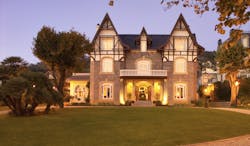
Villa Soro in San Sebastián is an exclusive 4-star boutique hotel in a fantastic location near the old town and the beach. Beautiful gardens and luxurious accommodation make this a truly relaxing and restorative retreat.
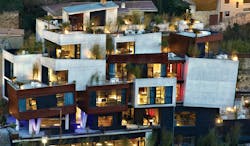
Hotel Viura is a 4-star hotel in a striking modernist building situated in a traditional wine village. Cuisine and wine are a strong focus here at the heart of Rioja wine country.
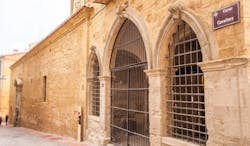
The Parador de Lleida is a 4 star hotel located in the Convento del Roser. The hotel opened in 2017 but the convent dates back to the 17th century. The winding streets of the historic centre, as well as the city's two cathedrals, are located within easy walking distance
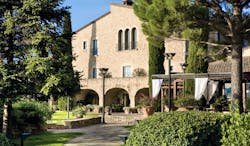
Mas de Torrent is a 5-star luxury boutique hotel and Relais & Chateaux member, offering a peaceful haven only a few minutes from the busy resorts of the Costa Brava. Gourmet cuisine, excellent spa facilities, alongside luxurious accommodation afford guests a secluded, relaxing retreat.
Big thank you for getting us into some lovely hotels on our holiday: the suite at the Santiago parador was outstanding and Villa Soro in San Sebastian an absolute delight. We are now planning our next trip...JG, September 2022
Holiday price guide Prices from £2,660 per person based on two people sharing a double or twin room.
Holiday Code SNFD14
Call us on 01392 441245
Luxury fly-drive touring holiday from the Basque Country to Catalonia visiting La Rioja and Aragon
About Spanish Basque country
An Expressions tailor-made holiday to the Basque Country in northern Spain include the very best four and five star hotels across the region, including seaside retreats, city properties and vineyard hotels in La Rioja. Lying at the point between the Pyrenees and the Bay of Biscay is the Basque Country, a name which refers both to an autonomous community within Spain and to a larger cultural area which comprises parts of Spain and France. Known in Spanish as the Pais Vasco, you will find a unique culture here with fascinating traditions and a regional language which is widely spoken throughout. The region's key attraction is the closeness of both sea and country - the spectacular coastline boasts sweeping sandy beaches and rugged cliffs, stunning sunsets over the ocean and surf breaking on rocks; but only a short drive inland are rolling green hills and flower filled fields. Lying around 10 miles away from the north coast is the vibrant and energetic riverside city of Bilbao, whilst further east is San Sebastian, an elegant seaside resort set on a beautiful bay only a few miles away from the French border. Stretching away from the Basque coast and forming the border with France are the Pyrenees, where rocky mountains with waterfalls and lakes stretch into Navarre, a region which is dotted with unspoiled villages and mediaeval towns which line the pilgrimage route to Santiago de Compostela. Further west are the undulating hills of La Rioja, a region whose name is synonymous with the fine wines that it produces. Although parts of the region are heavily industrialised, there are many areas of unspoiled countryside as well as over 150 miles of coastline, making it a superb destination for a luxury holiday. The natural environment has long played a huge role in the lives of the region's inhabitants, with charming fishing villages along the coast which celebrate marine festivals as well as mountain farmers inland whose traditions remain unchanged. Throughout the region, visitors are sure to experience the unique culture of the Basque country through its language, cuisine and traditions.
Cultural highlights of Spanish Basque country
Bilbao's Guggenheim Museum, a Frank Gehry-designed landmark which transformed the city. The charming old town of San Sebastian, located between the beach and the river. Vitoria-Gasteiz, the capital of the Basque Country which is home to a mediaeval old town and two cathedrals. Guernica, a small town which was bombed during WWII and inspired a famous painting by Picasso. Fishing villages between Bilbao and San Sebastian including Bakio, Bermeo, Zumaia and Lekeitio, some of which are home to wonderful beaches and are also popular surf spots. Hondarribia, a historic town situated on the border with France. Pelota, a traditional ball game which is played throughout the region on a two-walled court. Numerous bars across the region which serve ‘pinchos’ (a Basque version of tapas), including those in Logroño. Wine-producing towns across La Rioja where visitors can enjoy cellar tours and wine tastings, which can also be enjoyed at the luxury vineyard hotels which we feature. Yuso and Suso Monasteries, a UNESCO World Heritage Site in La Rioja. The fortress city of Pamplona, renowned for the annual bull running festival.
Gastronomy of Spanish Basque country
The Basque Country is renowned for its varied and innovative cuisine, with numerous Michelin-starred restaurants found across the region. San Sebastian alone is home to eight Michelin-starred restaurants, two of which have been included within the top ten of Restaurant magazine's list of the world's 50 best restaurants. Wine is of course an incredibly important product, primarily in La Rioja which is known for its high-quality reds as well as a number of good white and rosé wines. A regional variation of tapas called ‘pinchos' can be found throughout the Basque Country and Navarre, frequently eaten as a snack in bars. Regional cooking varies according to location, with plenty of fresh fish and shellfish to be found along the coastline and a greater use of meat and game further inland. Local dishes include ‘Bacalao' (salt cod), ‘Marmitako' (fresh tuna stew), ‘Cordero al Chilindron' (spicy lamb stew) and ‘Txangurro relleno' (stuffed spider crabs).
Festivals in Spanish Basque country
19 to 20 January: San Sebastian Drum Festival, 29 June: Haro Wine Festival, 6 to 14 July: Los Sanfermines Bull Running Festival (Pamplona), July: San Sebastian Jazz Festival, 4 to 9 August: Festival of the Virgin Mary (Vitoria-Gasteiz), August: Bilbao's Big Week, September: San Sebastian International Film Festival, September: San Mateo Wine Festival (Logroño).
Climate in Spanish Basque country
The Basque Country's climate is generally quite mild and wet, although there is some variation between coastal and inland areas. The Basque coast experiences relatively high levels of rainfall, cold winters and warm summers where temperatures regularly reach 25 degrees, whilst some areas further south enjoy a Mediterranean climate, with hot summers and little rain.
Call us on 01392 441245
Luxury fly-drive touring holiday from the Basque Country to Catalonia visiting La Rioja and Aragon
About Catalonia and Eastern Spain
An Expressions tailor-made holiday to eastern Spain feature some of the best four and five star hotels in Catalonia and Valencia, including luxury beach resorts on the Costa Brava, mountain retreats in the Catalan Pyrenees and city hotels in Barcelona and Valencia. Eastern Spain is a diverse area with buzzing cities and mediaeval towns, rugged coastline and sandy beaches, soaring mountains and lush river deltas. There is a great wealth of historical and cultural sights throughout Catalonia and the Valencian community, both within the main cities and hidden away in the countryside. Although Barcelona is the main draw for visitors to eastern Spain, the rest of the region is well worth visiting and offers tremendous diversity. During a holiday in eastern Spain, visitors can trek or partake in mountain sports, relax on the beach and visit historic towns and cities all within the space of a few days. Catalonia itself is a unique region which provided inspiration for a number of famous artists such as Dali and Picasso, and retains a strong regional identity which is evident in its language, distinctive cuisine and lively local festivals. In the north is Catalonia, whose capital is the dynamic and cosmopolitan city of Barcelona. With unique architecture and a rich culture, gourmet restaurants and lively bars, golden beaches and tranquil parks, it is not surprising that Barcelona is one of the most visited cities in Europe. Away from the city there is an abundance of cultural and historical attractions as well as areas of stunning natural beauty. The entire region retains a strong regional identity, with its own commonly used language, distinctive cuisine and lively local festivals. Towns and cities including Girona, Tarragona, Vic and Lleida are home to a variety of highlights including mediaeval castles, cobbled old towns, ancient Roman ruins and modernist architecture. Stretching north towards the French border are the pretty coves, jagged cliffs and golden beaches of the Costa Brava, where you can still find wild and untouched stretches of coastline in between busy coastal towns. Meanwhile, inland are the snow-capped Pyrenees, a towering mountain range which forms the border with France and is dotted with remove villages, an ideal setting for trekking and partaking in mountain sports. Past the vineyards and rice fields of southern Catalonia is the Valencian Community, whose capital is Spain's third-largest city. Valencia has reinvented itself in recent years with futuristic architecture and a sophisticated port area which contrast with the historic buildings of the atmospheric old town. Further south are the sprawling beach resorts of the Costa Blanca, but if you head away from the Valencian coastline you will find craggy mountains, peaceful nature reserves, colourful citrus groves, traditional villages and ancient fortresses.
Highlights of Catalonia and Eastern Spain
Barcelona's Gothic quarter, a maze of narrow streets and plazas which is home to historic buildings including La Seu Cathedral. Modernist architecture throughout the region, particularly in Barcelona where Gaudí designed works including the Sagrada Familia church and Park Guell. Green spaces within Barcelona such as Montjuic, a fortress-topped hill, and Parc de la Ciutatella, a popular park with a zoo and several museums. The City of Arts and Sciences and the Fine Arts Museum in Valencia. Historic monuments within Valencia including a 15th century silk exchange and a Cathedral, home to a Holy Chalice which is said to be the Holy Grail. The Monastery of Montserrat, a religious complex in a spectacular setting atop craggy mountains with chapels, hermits' caves and numerous nature trails. Wineries in towns such as Sant Sadurní d'Anoia and Vilafranca del Penedès. Tarragona, a port city with fascinating Roman remains. The ancient walled city of Girona. Vic, a quintessentially Catalan town with an outstanding market. Cardona, a picturesque town with an impressive fortress. The renowned Dalí Theatre-Museum in Figueres. Charming towns along the Costa Brava such as Cadaques, as well as those further inland such as the colourful town of Begur. Pretty villages in the Pyrenees, where visitors can also hike and partake in mountain activities. Wildlife in the wetlands of the Albufera Natural Park.
Festivals in Catalonia and Eastern Spain
March: Las Fallas festival of fire (Valencia), 23 April: Celebration of Catalonia's patron saint, April: Barcelona April Fair, May: Girona flower fair, 23 June: Midsummer's Eve Festival, July: Valencia July Fair, July/August: Begur Music Festival, August: La Tomatina tomato throwing festival (Buñol), 11 September: National day of Catalonia, September: Celebration of Barcelona's patron saint, September/October: Human tower festivals (near Tarragona).
Gastronomy in Catalonia and Eastern Spain
Cuisine in eastern Spain takes inspiration from both nearby France and from central Spain whilst making use of local ingredients available including seafood, fresh vegetables, meat and game. Paella, the rice dish which is known the world over originated in Valencia. Barcelona is home to some of Spain's best restaurants, with gastronomic chefs creating innovative cuisine and over 20 boasting at least one Michelin star. Typical dishes include unusual ‘sea and mountain' combinations which use both meat and seafood, ‘Pa amb tomàquet' (bread with tomato, oil and garlic), ‘Fideuá' (a variant of Paella with pasta), ‘Zarzuela' (a seafood stew), ‘Escudella’ (a stew containing vegetables, meat, rice and pasta) and ‘Crema Catalana' (a Catalan version of a Crème Brûlée).
Climate in Catalonia and Eastern Spain
Eastern Spain enjoys a typical Mediterranean climate, although mountainous areas are somewhat cooler. Late spring and early autumn are great times to visit coastal areas as the weather is warm with temperatures of around 20 degrees centigrade, although some rainfall can be expected. Summer in the cities can be unbearably hot, but the coastline is cooled by sea breezes. Winter is generally mild with occasional rain and average temperatures of 10 degrees, whilst temperatures regularly drop below freezing in the Pyrenees and snow often falls.
Call us on 01392 441245
Luxury fly-drive touring holiday from the Basque Country to Catalonia visiting La Rioja and Aragon
About Navarre and Aragon
The regions of Navarre and Aragón offer the opportunity to explore a largely unsung and under-visited region which stretches almost half the length of Spain. Its reaches include the famed city of Pamplona, best known for its daredevil bull-running in July, medieval castles and Romanesque churches and the exquisite Mudéjar architecture found across the region with the finest example in Zaragoza. Navarre was a medieval Basque kingdom and the Euskadi/Basque language is still recognised as co-official with Spanish in several areas. To the north of the regional capital lies the mountainous border with France, a vivid landscape of forested slopes and lush valleys whilst the centre of Navarre consists of wide basins and gentle hills, carefully tended with crops, livestock and woodlands. The Ebro, the second longest river in the Iberian Peninsula, runs through the southern area of Tudela and leads westwards into neighbouring Aragón. Visitors to Aragón will find a vast landscape of picturesque ancient villages, rolling green foothills and arid plains in the southern reaches of Teruel. Above all, Aragón is set apart from the rest of Spain by the majesty of the Pyrenees which mark its northern border. The three highest peaks of this chain, Pico Aneto, Pico Posets and Monte Perdido, are all found within the borders of Aragón, giving some of Spain’s finest hiking and adventure sports. Visitors to Navarre and Aragón will find that the variation in climate is just as dramatic as the changing landscape with often long, harsh winters and hot, balmy summers. Many of our hotels in Navarre and Aragón are housed in significant historic buildings, providing guests with elegant and comfortable accommodation options. The regions of Navarre and Aragon are particularly well suited for touring holidays in combination with different areas of Spain such as the Spanish Basque Country, Catalonia and Eastern Spain or the Heart of Spain.
Highlights of Navarre and Aragon
The Gothic cathedral in Pamplona (Iruña), a major stop on the Way of St James pilgrimage route through northern Spain, as well as the opulent Palacio del Gobierno de Navarra. The town of Tudela with its 13th century bridge across the River Ebro and beautiful old town, in addition to the otherworldly landscape of the nearby Bardenas Reales National Park. The charming town of Sos del Rey Católico, birthplace of Fernando of Aragón, with the grand Palacio de Sada and Church of San Esteban. The riverside Cathedral-Basilica of Our Lady of the Pillar in Zaragoza, the second largest church in Spain, celebrated for its eleven brightly coloured domes and elegant Baroque façade. Classic examples of Mudéjar architecture which combines Gothic and Islamic elements, some of the best examples of which are in the high-altitude town of Teruel in southern Aragón. Tranquil religious houses including the Cistercian Monastery de la Olivia and isolated Monastery of San Salvador de Leyre. Perhaps the most unique of these buildings is the Monastery of San Juan de la Peña in Aragón; set under an overhanging rock, this monastery was a supposed guardian of the Holy Grail. Formidable castles such as the Castillo de Loarre where visitors can explore the ramparts, dungeons and keep. The medieval old town of Huesca topped with its impressive gothic cathedral and nearby Castle of Montearagón. The stunning landscape of Ordesa National Park draws guests with its well-marked hiking trails, native wildlife and scenic “Horse’s Tail” waterfall. The small village of Torla is the gateway to the park and is a popular stopping point for visitors. Historic towns and villages, unspoilt by mass tourism, such as Estella (Lizarra), Olite, Albarracín, Ujué and Calahorra.
Festivals in Navarre and Aragon
January: Festive processions on the 5 January, marking the arrival of the Three Kings with huge floats. February: Festival of Santa Águeda in Alsasua. February/March: Carnivals celebrating the start of Lent, one of the best is in the town of Bielsa. March/April: Easter celebrations such as Las Tamborradas in the Aragonese town of Hijar and El Volatín in Tudela. Festival of Dance with performances throughout spring weekends in Pamplona. April: Traditional pilgrimage of San Marcos in Ujué on 25 April. July: San Fermín, the famous bull-running festival in Pamplona. International music festival of Navarre and also another in the medieval castle at Aínsa. Traditional Romero pilgrimage in Yebra de Basa. Tudela’s festival in honour of their patron saint, Santa Ana. July/August: Pyrenean Folk Festival in Jaca. Pyrenees South International Festival of Cultures in Huesca. Classical Theatre Festival in Olite. August: Medieval festival in Olite with market and historical demonstrations of trade and fashion. September: La Morisma, a re-enactment of an 8th century battle between Christians and Moors in Aínsa. October: Fiestas de Pilar in Zaragoza, a week-long celebration in honour of the city’s patron saint. November: Cinema Festival in Pamplona. December: El Olentzero - Christmas Eve celebrations across Pamplona and Navarre include this traditional Basque character who comes late at night to drop off presents for children.
Gastronomy in Navarre and Aragon
Cuisine across these regions is varied with tastes to suit everyone’s palate, thanks to the vast landscape and products grown here. Whilst there is no coastline, there is great choice with plentiful meat and game, locally grown crops and vegetables and fresh-water fish. Cuisine is based on traditional recipes which have been handed down through generations and modernised. In Aragón you will find menus featuring stews, ternasco (roasted lamb) and jamón from Teruel. Not all Aragonese cooking is based on meat with river-caught fish like trout and eel also used. Try local olive oil from Empeltre, asparagus from the banks of the Ebro and sweet onions from Fuentes. Fruits grown in Aragón include pears, apples, cherries and plums and are exported throughout Spain. The gastronomy in neighbouring Navarre is not dissimilar yet offers additional treats such as black truffles from the Allín valley and woods of the Lóquiz mountains. Dining out in Pamplona is a treat with restaurants to match all budgets and styles, from local bars to Michelin-starred destinations. Whatever your choice, be sure to try the local wines as well as the Navarran spirit pacharán, made with sloe berries and anise.
Climate in Navarre and Aragon
This part of Spain has a mixed climate which is inextricably linked with the contrasting landscape. The northern areas are amongst the coldest in Spain with the winter months of November to April often bringing freezing temperatures, snow and making mountain roads impassable. On the other hand, the arid plains of southern Aragón can be very hot in the summer months with residents and visitors alike spending the warmest hours relaxing inside. Rain falls throughout the year in the northern areas, although with less frequency throughout the summer. We recommend speaking to one of our Personal Travel Specialists about your interests in order to suggest the best time for your visit.
Call us on 01392 441245
Luxury fly-drive touring holiday from the Basque Country to Catalonia visiting La Rioja and Aragon
About La Rioja
La Rioja, by Spanish standards, is a small and compact region in the north of Spain, to the south of the Basque country and north of Castile and Leon. Sheltered from the Atlantic by the Sierra de Cantabria, La Rioja is a region whose name is synonymous with the high-quality wine produced in over 500 wineries. The vineyards form a patchwork on gently rolling hills and terraces above the valley of the River Ebro and are divided into three zones: Rioja Alta, Rioja Alavesa and Rioja Baja. Each of these areas has a wine route the visitor can follow. Many of the wineries have been run by the same families with expert knowledge passed through the generations for centuries, whilst others are set apart by their stunning modern architecture. The Marques de Riscal winery is one place which combines both elements; founded in 1858 it is one of the oldest wineries in La Rioja but is also known for its iconic building which was designed by world-renowned architect Frank Gehry. As well as the wineries, La Rioja is also known for its cultural significance and magnificent religious buildings. The town of Santa Domingo de la Calzada is a key stop on the St James’ Way pilgrimage route which traverses northern Spain and the cathedral here is well worth visiting. Meanwhile in the city of Logroño guests will find the Cathedral of Santa María de la Redonda with its twin baroque towers and elegant façade. The Ebro River winds lazily through the city and visitors can enjoy a relaxed, self-guided tour of the town, stopping in at the many bars to try the local pintxos paired with local wines.
Highlights of La Rioja
Wine-producing towns across La Rioja DOC region where visitors can enjoy cellar tours and wine tastings, which can also be enjoyed at the luxury vineyard hotels which we feature. La Rioja is subdivided into three zones; Rioja Alta, Rioja Baja and Rioja Alavesa. Follow the wine routes of each of these areas. The beautiful Iglesia de San Bartolomé and cathedral in Logroño. The Cathedral of Santo Domingo de la Calzada, stopping point on the Saint James’ Way pilgrimage route. Numerous bars across the region which serve ‘pintxos’ (a Basque version of tapas), including those in Logroño. The attractive old town of Haro. The Museum of Wine Culture in Vivanco. San Millán Yuso and Suso (Upper and Lower) Monasteries, a UNESCO World Heritage Site in La Rioja, known for their role in the early development of the Spanish language. The hilltop walled town of Laguardia. Walking and nature watching in the Sierra de Cameros Natural park near Soria. “El Barranco Perdido” paleontology-themed amusement park. The pretty village of Ezcaray in the Oja River Valley, made wealthy by the wool trade, is popular with visitors for its outdoor pursuits and host of tapas bars.
Festivals in La Rioja
April: “Los Picaos” Easter procession in San Vicente de la Sonsierra. May: Saint’s Day festivities in Santo Domingo de la Calzada. June: Festivities of San Bernabé in Logroño, Haro Wine Festival and the Battle of Wine, Briones Medieval Festival. August: Bread and Cheese Festival in Quel. September: San Mateo Wine Harvest Festival (Logroño).
Gastronomy in La Rioja
La Rioja is best-known for its high-quality reds as well as many excellent white and rosé wines. A regional variation of tapas called ‘pintxos’ can be found throughout La Rioja, frequently eaten as a snack in bars. Enjoying pintxos like a local means visiting several bars and trying one or two small dishes in each, accompanied by local wines. Regional cooking varies from place to place but the key flavours and ingredients are simple and wholesome with high quality products from the region. Of particular note are the traditional stews made with fava or caparrón beans and a wide array of vegetables and pulses. Christians and Muslims have each left their mark on the region with pork and lamb forming popular bases for dishes, whilst fish caught from the Ebro also appear on the menu.
Climate in La Rioja
La Rioja is one of the colder regions of Spain and tends to have fairly mild summers and wet winters. The preferred time for visitors tends to be from June to September with most tourists avoiding the winter months of November to March. This part of Spain escapes the fierce summer heat found in the centre and south of the country with pleasant temperatures of around 20-25 degrees typical.



